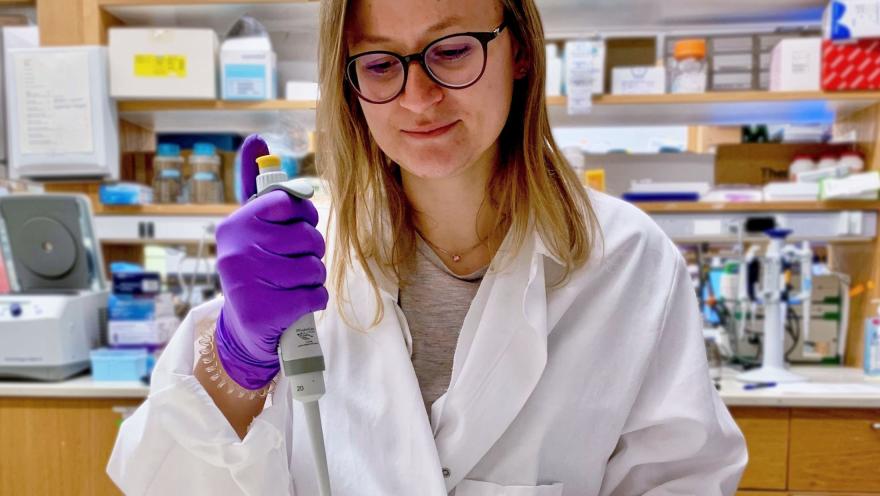To find new treatments and a cure for ALS, it’s vital to have a dedicated network of scientists working to advance our understanding of the disease and thinking creatively about solutions.
We are proud to support the development of bright, young researchers – and their innovative ideas – through our Milton Safenowitz Postdoctoral Fellowship Program. Established in memory of Milton Safenowitz by the Safenowitz family, this unique program encourages young scientists to enter and, importantly, remain in the ALS field. After completing this fellowship, more than 75% of awardees stay in ALS research. Many go on to establish their own laboratories and mentor more ALS researchers along the way.
During the 2022 funding cycle, five new Safenowitz fellows were selected from a highly competitive applicant pool, including Dr. Miriam Linsenmeier, a postdoctoral fellow at the University of Pennsylvania’s Perelman School of Medicine. We talked with her to learn more about her research, as well as her interests outside the lab.
What made you want to focus on ALS research?
My interest in ALS research ignited as an undergraduate student at Ulm University in Germany, where neurodegenerative diseases are among the core research areas. During an internship in the neuropathology laboratory, I learned about the complex cellular processes underlying the pathogenesis of ALS and how it dramatically affects patients and their families. From that moment, I wanted to contribute with my research to understand the molecular details of this devastating disease with the aim of finally developing an effective therapeutic.
What are the goals of your funded research project?
The project centers on the protein TDP-43. This protein is normally located in the nucleus of neuronal cells, which control muscle contractions and movement. In more than 95% of people living with ALS, TDP-43 erroneously accumulates outside of the nucleus and loses its normal function. Likely, these processes are key events in the loss of neurons in ALS.
To create a treatment able to combat TDP-43-based ALS, a potential drug would need to be able to (1) prevent aberrant accumulation of TDP-43, and (2) transport the protein back to the cell nucleus to ensure its normal function. The goal of my funded project is to develop a novel protein-based drug candidate that exhibits this dual activity and antagonizes TDP-43 pathology in a specific and tailored way.
Luckily, nature has already developed proteins capable of performing this task. I will screen this protein family to identify the naturally most efficient candidate. I will then modify the top candidate to obtain an optimized variant. This modified version will be highly efficient and specialized in counteracting faulty TDP-43 accumulation and mislocalization at the same time.
I hope to further develop this drug candidate toward clinical application, paving the way to a successful ALS therapy.
How might your work impact the ALS community?
I hope to develop a promising novel drug candidate with the potential to be translated into an effective treatment. Perhaps our work may be able to give people living with ALS and their families a little bit of hope, knowing that many researchers around the globe are working tirelessly to develop a cure for ALS.
What role will this fellowship play in your research efforts?
The Milton Safenowitz Postdoctoral Fellowship will support the initial pre-clinical part of my research. A solid foundational understanding is essential for all future steps to reach the ultimate goal of developing an effective therapeutic for ALS.
What do you like most about working in the ALS research field?
I really enjoy the collaborative spirit within the global network of ALS researchers. They come from so many different scientific backgrounds. I have been inspired by the interactions with clinicians, biologists and biophysicists. They have made me think outside the box. I believe an interdisciplinary approach and sharing of expertise is crucial to move forward since ALS is such a complex disease.
What gives you hope that there will one day be a world without ALS?
The Ice Bucket Challenge over social media raised a lot of awareness about ALS and helped boost research through its fundraising. In turn, those funds produced many exciting and new discoveries over the last few years. These advances, together with newly developed technologies and bright, hard-working and passionate scientists, make me hopeful that we are well on our way to a world without ALS.
What do you like to do outside of the lab?
I love the outdoors, so activities such as running, hiking and skiing bring me joy. I regularly explore the different neighborhoods in Philadelphia, usually culminating in spending time in one of the parks with a nice cup of coffee and a book.
Is there anything else you’d like to add?
I am thankful for The ALS Association and the Safenowitz family for supporting my work! I am really grateful for this opportunity and very enthusiastic to work on this project.
If you would like to receive monthly ALS research updates, SUBSCRIBE to our newsletter, Research Matters.
To continue to follow stories about people living with ALS in the community and learn more about the disease, subscribe to receive our weekly blogs in your inbox HERE or follow us at als.org/blog.


Join the conversation. Please comment below.